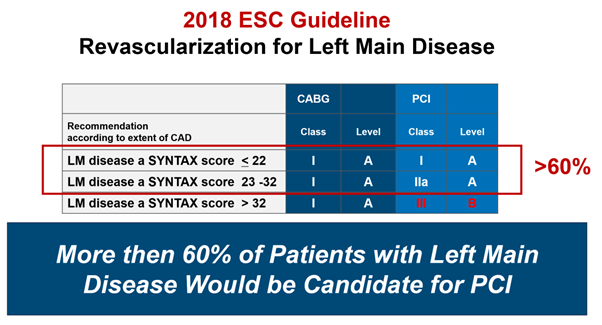News | TCTAP 2024
Revascularization for Left Main Disease: Updated Data, Global Guideline and Beyond
Left Main and Multi-Vessel Diseases: Updated Concept and Treatment

Seung-Jung Park
Asan Medical Center, Republic of Korea
During a recent lecture at Asan Medical Center, Seung-Jung Park, MD, PhD (Asan Medical Center, Seoul, Korea) shared critical updates on revascularization for left main (LM) coronary artery disease, incorporating global guidelines and innovations beyond traditional methods. His discussion, based on significant clinical research and trials such as SYNTAX, PRECOMBAT, NOBLE, and EXCEL, focused on the relative merits of percutaneous coronary intervention (PCI) versus coronary artery bypass grafting (CABG).
Park presented findings from a meta-analysis of 4,394 patients, which indicated that over a decade, there was no notable difference in all-cause mortality between PCI and CABG arms. These results highlight the intricate decision-making process in selecting the appropriate revascularization strategy, influenced by the coronary complexity assessed by the SYNTAX score (Figure 1).

Figure 1. Candidates for PCI in those with left main disease, based on the 2018 ESC guideline.
The lecture also delved into the significance of physiological and imaging techniques in enhancing PCI outcomes. Park stressed the importance of tools such as fractional flow reserve and intravascular ultrasound, which are essential for a more accurate clinical assessment and revealing the functional severity of coronary lesions that angiography might overlook.
In discussing technological advancements, evolving PCI methods were mentioned, including dual stenting for complex bifurcation lesions, which showed promise in keeping vessels open and reducing restenosis. Such advancements are indicative of a shift towards more precise and individualized approaches in managing LM disease, aligning with the principles of personalized medicine.
Furthermore, Park emphasized the need for tailored revascularization strategies that consider each patient's unique anatomical and comorbidity profiles to maximize treatment outcomes. This approach underscores a substantial shift in the treatment paradigm for LM coronary artery disease, moving away from traditional surgical methods.
The concluding message, "LM Disease is Not a Surgical Disease Anymore!"
indicates a significant turning point in the field. The progress in imaging and physiology-guided PCI has greatly enhanced clinical outcomes, proving that non-surgical methods are not only feasible but also highly effective. Particularly, the strategy of deploying upfront dual stents in cases of true bifurcation has been shown to be both safe and beneficial. This approach reflects the ongoing refinement in interventional cardiology, where precise, tailored treatments enhance patient recovery and long-term health, steering away from more invasive surgical options.
TCTAP Workshops
Left Main and Multi-Vessel Diseases: Updated Concept and Treatment
Thursday, April 25, 2:00 PM ~ 3:50 PM
Valve & Endovascular Theater, Level 2
Edited by

Ju Hyeon Kim, MD
Korea University Anam Hospital, Korea (Republic of)

Seung-Jung Park
Asan Medical Center, Republic of Korea
During a recent lecture at Asan Medical Center, Seung-Jung Park, MD, PhD (Asan Medical Center, Seoul, Korea) shared critical updates on revascularization for left main (LM) coronary artery disease, incorporating global guidelines and innovations beyond traditional methods. His discussion, based on significant clinical research and trials such as SYNTAX, PRECOMBAT, NOBLE, and EXCEL, focused on the relative merits of percutaneous coronary intervention (PCI) versus coronary artery bypass grafting (CABG).
Park presented findings from a meta-analysis of 4,394 patients, which indicated that over a decade, there was no notable difference in all-cause mortality between PCI and CABG arms. These results highlight the intricate decision-making process in selecting the appropriate revascularization strategy, influenced by the coronary complexity assessed by the SYNTAX score (Figure 1).

The lecture also delved into the significance of physiological and imaging techniques in enhancing PCI outcomes. Park stressed the importance of tools such as fractional flow reserve and intravascular ultrasound, which are essential for a more accurate clinical assessment and revealing the functional severity of coronary lesions that angiography might overlook.
In discussing technological advancements, evolving PCI methods were mentioned, including dual stenting for complex bifurcation lesions, which showed promise in keeping vessels open and reducing restenosis. Such advancements are indicative of a shift towards more precise and individualized approaches in managing LM disease, aligning with the principles of personalized medicine.
Furthermore, Park emphasized the need for tailored revascularization strategies that consider each patient's unique anatomical and comorbidity profiles to maximize treatment outcomes. This approach underscores a substantial shift in the treatment paradigm for LM coronary artery disease, moving away from traditional surgical methods.
The concluding message, "LM Disease is Not a Surgical Disease Anymore!"
indicates a significant turning point in the field. The progress in imaging and physiology-guided PCI has greatly enhanced clinical outcomes, proving that non-surgical methods are not only feasible but also highly effective. Particularly, the strategy of deploying upfront dual stents in cases of true bifurcation has been shown to be both safe and beneficial. This approach reflects the ongoing refinement in interventional cardiology, where precise, tailored treatments enhance patient recovery and long-term health, steering away from more invasive surgical options.
TCTAP Workshops
Left Main and Multi-Vessel Diseases: Updated Concept and Treatment
Thursday, April 25, 2:00 PM ~ 3:50 PM
Valve & Endovascular Theater, Level 2
Edited by

Ju Hyeon Kim, MD
Korea University Anam Hospital, Korea (Republic of)

Leave a comment